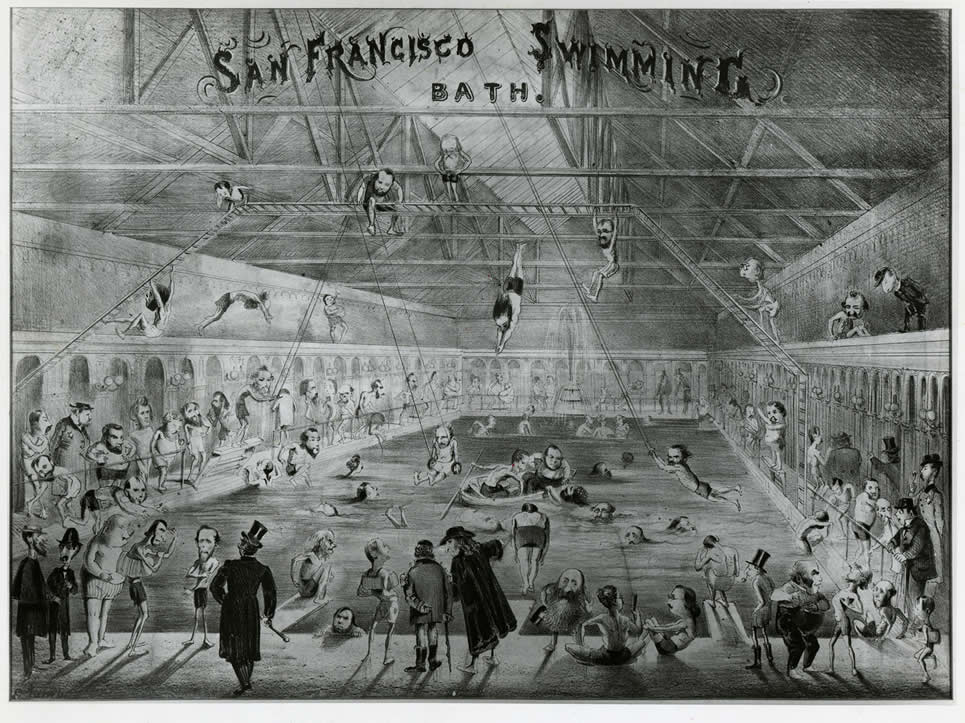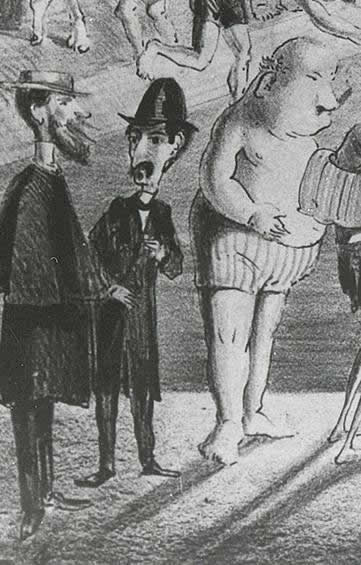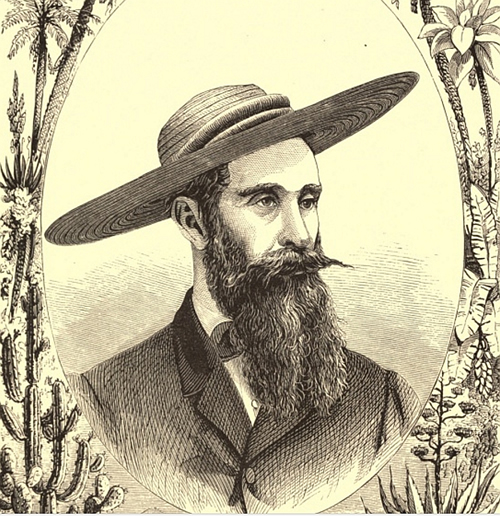Direct testimony that Clemens is not in Jump's picture must certainly be
taken into account. Damaging as it must seem, however, it cannot be taken
at face value: it is just one salvo of many in a long campaign of disinformation
about Mark Twain, written for a distant readership. It is odd that Evans
omits to mention that he himself has the honor of being caricatured in the
"Bath." Is it possible he hadn't seen it? It may also be remembered
that Mark Twain had already razzed Evans by claiming that he himself ("Fitz
Smythe") was pictured among the swimmers, "naked or clad in tights,
it is impossible to determine which," on the painted panorama on the
front of the Swimming Bath building (11).
"Mike Reese," mentioned by Evans as one of the habitual "denizens"
of Jump's pictures, is the massive individual to the right of the figure
I am identifying as Mark Twain. He, too, is someone with whom Mark Twain
was currently entangled. One of the city's richest men, Michael Reese (1817-78)
was much in the news in February 1866, and Mark Twain, among others, handled
him pretty roughly. Reese was being sued for $100,000 by a seamstress who
claimed he had promised to marry her. In fact, at this moment, Reese was
being sued by Jump himself, the artist claiming that Reese had not paid
for a portrait he commissioned (12).
Reese's reputation as a miser would later be redeemed by his many charitable
bequests, which included $50,000 to the fledgling University of California
Library; the Michael Reese Fund is still being used today to build the collections.
Mark Twain's letters containing his comments on Reese, not reprinted since
their original publication and surviving in just a single copy, are included
in the Mark Twain Project's forthcoming edition of the San Francisco
Correspondence, 1865-1866.
Richard Bucci, to whose research on the early journalism I am much indebted,
suggests that Mark Twain may be depicted in a still earlier Jump lithograph.
Earth Quakey Times commemorates the San Francisco earthquake of 8
October 1865.
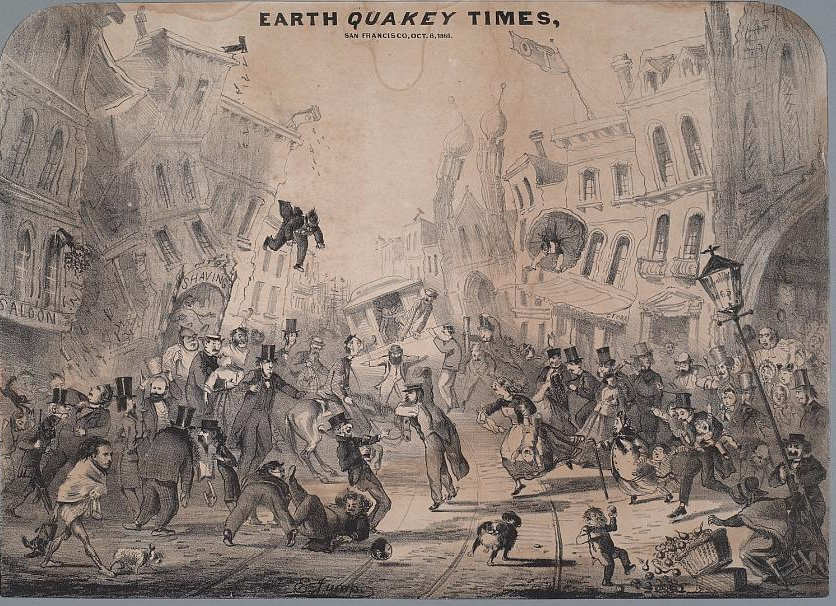
Earth
Quakey Times,
by Edward Jump. October 1865. The Bancroft Library.
The figure clutching a lamp-post in the lower right corner could
be intended for Mark Twain, but I am not sure. The discrepancy between this
physiognomy and that in the Bath is jarring; Jump's caricatures are
usually more consistent than this. The Earth Quakey Times figure,
with its round head and baggy clothing, might be Bret Harte.
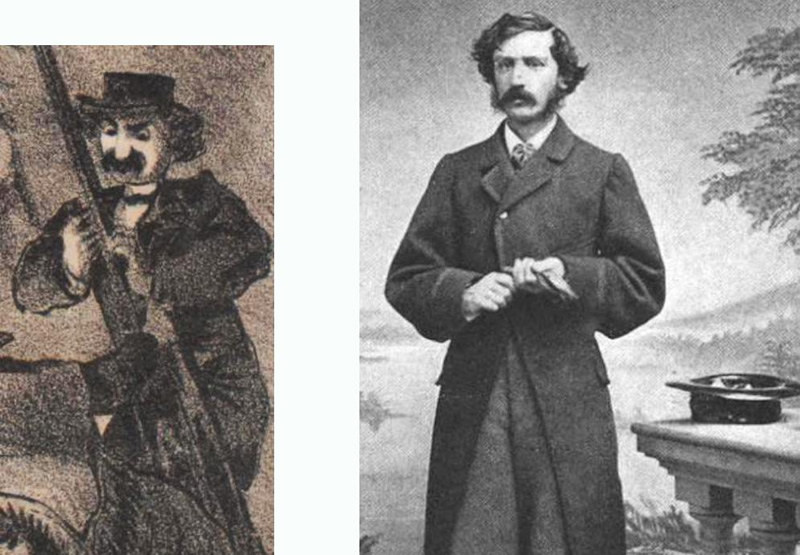
Detail,
Earth Quakey Times; and photo of Bret Harte, 1861. Note the hats!
Jump left San Francisco for the East -- what Californians
used to call "the States" -- late in 1866. His farewell to the
city was The Last Jump, an unsigned and, we are told, freely distributed
print. The artist's self-caricature shows him, small and hairy, departing
the city in a hot air balloon.
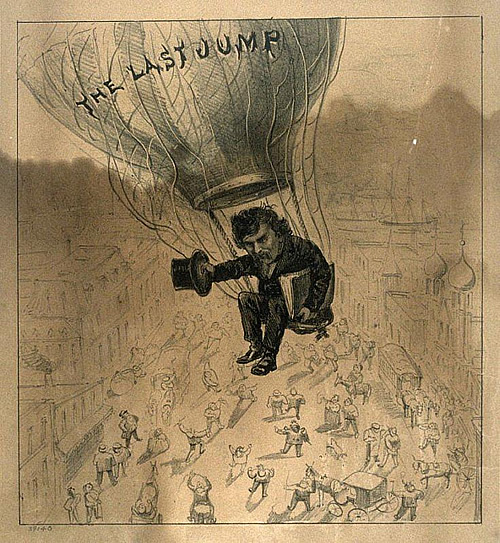
The Last
Jump,
by Edward Jump. October 1866. M. H. De Young Memorial Museum.
In 1868 he married Emily Rogers, a light-opera soprano; they
had a daughter, Mora Josephine. (Some sources give her name as Maria Josephine
Jump.) Portrait-painting and cartooning, he moved his family from Washington
D.C. to New York, Cincinnati, New Orleans, St. Louis, Montreal, and Chicago.
In 1883, Jump shot
himself in the head; newspapers across the country told lurid tales
of alcoholism and penury. In a letter to the New York Tribune, Frank
Bellew countered these, up to a point, from personal knowledge, but certain
stubborn facts remain. Jump and his wife were heavy drinkers, their daughter
had been placed in a convent in St. Louis, and their constant removals bespeak
a troubled existence. Emily Rogers Jump was committed to an inebriate asylum
in 1885 (13).
Albert Evans prospered, promoted a mining boom that went bust,
published a book on Mexico, and worked hard to attach himself to the great
and powerful. He made himself prominent in the Associated Press, and obtained
a position on the staff of California's Governor which carried with it the
rank of Lieutenant Colonel in the National Guard. After 1 January 1869 he
invariably goes under his military title. "Colonel Albert S.
Evans's trip through Mexico! Who made him a Colonel?" thundered Clemens.
"He would run from a sheep." Evans died in 1872 when the steamship
Missouri was lost at sea (14).
Mark Twain left for the East around the same time Jump did.
Steadily gaining fame, he corresponded for newspapers in Washington, New
York, and San Francisco, and courted Olivia Langdon, whom he would marry
in 1870. He always affected to despise newspaper work, yet it had been the
rough-and-tumble of the frontier press that fired his spirit and showed
him "the way to write -- peppery and to the point. Mush-and-milk journalism
gives me the fan-tods" (15).
~~~~~
Selected San Francisco Lithographs
by Edward Jump
Emperor Norton Lunching Bummer & Lazarus. Published
before 3 October 1863, when Lazarus was reported dead ("Lament
for Lazarus," San Francisco Evening Bulletin, 3 October
1863, 2). If, as tradition holds, this is the picture that stirred
the Emperor Norton to violence, then February 1863 is an approximate
date ("Vive l'Empereur," San Francisco Alta California,
14 February 1863, 1). This picture was entered into evidence when
Jump sued a client (San Francisco Alta California, 28 February
1864, 1). Bancroft Library.
Untitled ["Stock Brokers"]. Published
before 3 October 1863, when Lazarus was reported dead. "Bummer
and Lazarus," San Francisco Morning Call, 3 July 1892,
9, reproduces this print and identifies some of the subjects.
Bancroft Library.
Funeral of Lazarus. Probably shortly after 3 October
1863. Bancroft Library.
San Francisco at the Fair. September 1864. See:
Californian 1 (3 September 1864): 9. Bancroft Library;
M. H. de Young Memorial Museum.
Earth Quakey Times, San Francisco, Oct. 8, 1865. 10?
October 1865. The Morning Call refers to this as Jump's
"second representation of Quaky Times" ("Jump at
It Again," 11 October 1865). See: "Earthquake Jumps,"
San Francisco Dramatic Chronicle, 12 October 1865, 2; "The
Earthquake in Caricature," San Francisco Evening Bulletin,
14 October 1865, 5; "Jump's Last," San Francisco Dramatic
Chronicle, 16 October 1865, 3. Bancroft Library; Huntington
Library.
Spring Races. May 1865. See: "Jump's Last,"
San Francisco Dramatic Chronicle, 16 May 1865, 3; "Lithographic
Caricatures," San Francisco Evening Bulletin, 19 May
1865, 3. De Young Museum.
The Political P.R. August 1865. Published in Puck
(San Francisco) for August 1865. Bancroft Library.
Bummer and Lazarus, the Damon and Pythias of San Francisco.
8 November 1865. The text is by journalist Tremenheere L. Johns.
See: "Published This Day [advertisement]," San Francisco
Evening Bulletin, 8 November 1865, 2; "In Memory of
'Bummer,'" San Francisco Evening Bulletin, 8 November
1865, 3; "Bummer," San Francisco Dramatic Chronicle,
10 November 1865, 3; "Bummer's Elegy," Californian
3 (11 November 1865): 9. Bancroft Library.
San Francisco Swimming Bath. February 1866. See:
"Jump's Last," San Francisco Dramatic Chronicle,
1 March 1866, 3; "Inigoings," Californian 4 (3
March 1866): 1; "Our San Francisco Correspondence,"
Gold Hill (Nev.) Evening News, 3 March 1866, 2. California
Historical Society.
The Law and the "Profits." March 1866.
See: Sacramento Union: "By Telegraph to the Union,"
13 March 1866, 5; and "The Law and the Profits," 16
March 1866, 2; "The Law and the Profits!" [advertisement],
San Francisco Alta California, 14 March 1866, 2. De Young
Museum.
California House of Assembly, 1865-6. April 1866.
See: "Assembly 'Jumped,'" San Francisco Alta California,
16 April 1866, 1. A letter to the San Francisco Evening Bulletin
datelined 30 March 1866 at Sacramento reports that Jump has set
up "a temporary studio" in one of the capital's drinking
saloons, where he is taking the portraits of the state assemblymen":
"Letter from Sacramento," 31 March 1866, 1. Bancroft
Library.
Steamer Day in San Francisco. April 1866. See:
"Jump's 'Steamer Day,'" San Francisco Evening Bulletin,
16 April 1866, 5; "Steamer Day," San Francisco Alta
California, 24 April 1866, 1. Bancroft Library; Library of
Congress.
Grand Municipal Turn 'em-out 1866. August 1866.
See: "The Election," San Francisco Dramatic Chronicle,
19 August 1866, 3. Bancroft Library.
After the Battle. September 1866. See: "After
the Battle," San Francisco Alta California, 9 September
1866, 1. Bancroft Library.
The Last Jump. October 1866. Jump left San Francisco
on the 30 October steamer ("Eastward Bound," San Francisco
Alta California, 30 Oct 1866, 1). An article in the Californian
speaks of a "forthcoming picture" bidding farewell to
San Francisco, though the description does not match this print:
"A Farewell Sketch," Californian 5 (20 October
1866): 9. De Young Museum.
|
~~~~~
NOTES
(1) "Jump, the Caricaturist,"
San Francisco Chronicle, 22 April 1883, 8.
(2) Frank Bellew, "Jump, the Caricaturist.
An Artist's Recollections of Him," New York Tribune, 14 May
1883, 2.
(3) "Jump, Edward," in Peter
E. Palmquist and Thomas R. Kailbourn, Pioneer Photographers of the Far
West: A Biographical Dictionary, 1840-1865 (Stanford, Calif.: Stanford
University Press, 2000), 342; Claudine Chalmers, "Splendide Californie!
Selections by French Artists in California History, 1786-1900," California
History 79 (2000-2001), 154-79 (pp. 166-68).
(4) "Amusements, Etc." San Francisco
Dramatic Chronicle, 3 October 1866, 3.
(5) "Linn C. Doyle," "Letter
from San Francisco," Stockton Evening Herald, 2 June 1866, 1.
The San Francisco Dramatic Chronicle observed that Doyle understated
Jump's height: five feet four inches ("Jump Jumped," 7 June 1866,
3).
(6) Mark Twain, "Opening of the New
Swimming Bath," San Francisco Alta California, 6 January 1866,
1; "San Francisco Letter," 11 January 1866. I quote Clemens's
journalism from the texts prepared by Richard E. Bucci for the forthcoming
Mark Twain Project edition of the San Francisco Correspondence, 1865-1866.
(7) Albert S. Evans (writing as "Amigo"),
"Our San Francisco Correspondence," Gold Hill (Nev.) Evening
News, 22 January 1866.
(8) Mark Twain, "San Francisco Letter,"
6 or 7 February 1866. Forthcoming Mark Twain Project edition of the San
Francisco Correspondence, 1865-1866.
(9) Mark Twain, "Fitz Smythe's Horse,"
21 January 1866. Forthcoming Mark Twain Project edition of the San Francisco
Correspondence, 1865-1866.
(10) Albert S. Evans, "Our San Francisco
Correspondence," Gold Hill (Nev.) Evening News, 3 March 1866,
2.
(11) Mark Twain, "Extraordinary
Delicacy," in "San Francisco Letter," 26-28 December 1865.
Forthcoming Mark Twain Project edition of the San Francisco Correspondence,
1865-1866.
(12) Charles H. Cutter, "Michael
Reese: Parsimonious Patron of the University of California," California
Historical Society Quarterly 42 (June 1963): 127-44; "The Troubles
of a Millionaire," Puck 2 (March 1866): 18; "The Troubles
of Michael Reese--He Uttereth Vulgar and Profane Language and Is Ordered
to Appear for Sentence," San Francisco Evening Bulletin, 8 March
1866, 3.
(13) Palmquist and Kailbourn; Chalmers,
168; Chicago Tribune: "Jump, the Artist. He Blows His Brains
Out in a Fit of Drunken Despair," 21 April 1883, 6; "Edward Jump.
The Coroner's Inquest -- His Last Letters," 22 April 1883, 8; "Jump
is a name . . . ," New York Sun, 25 April 1883, 2; Bellew, "Jump,
the Caricaturist" (see note 2 above); "From Footlights to the
Island," New York Herald, 26 June 1885, 6.
(14) The National Guard of California,"
San Francisco Alta California, 1 January 1869, 3; Mark Twain's Letters,
Volume 4: 1870-1871, ed. Victor Fischer, Michael B. Frank, and Lin Salamo
(Berkeley and Los Angeles: University of California Press, 1995), 216. An
unusually frank obituary is "Albert S. Evans," Los Angeles Star,
6 November 1872, 3. See also "California Authors: A Few Personal Sketches
and Reminiscences," San Francisco Chronicle, 1 May 1881, 1.
(15) Mark Twain, "Journalism in
Tennessee," Buffalo Express, 4 September 1869, 1, reprinted
in Sketches New and Old (Hartford: American Publishing Company, 1875).


